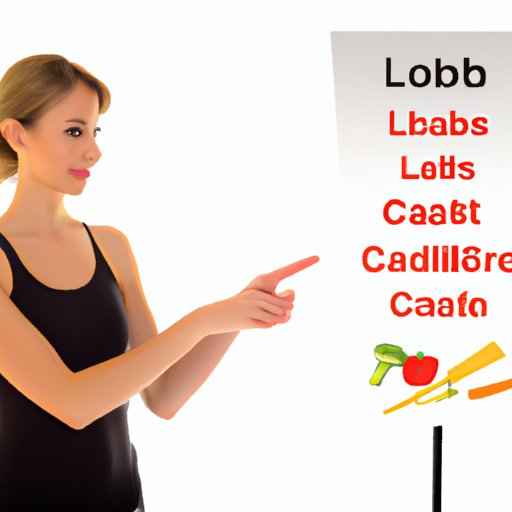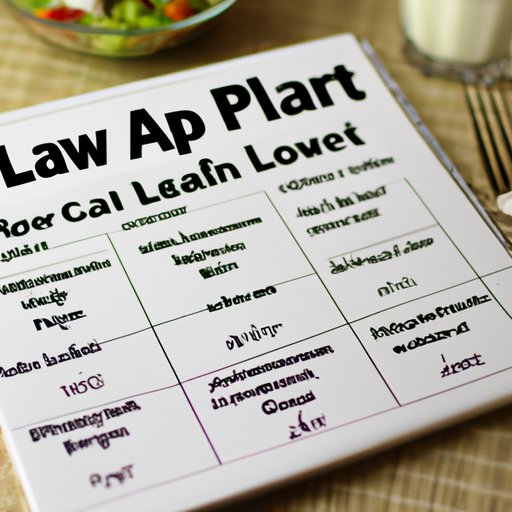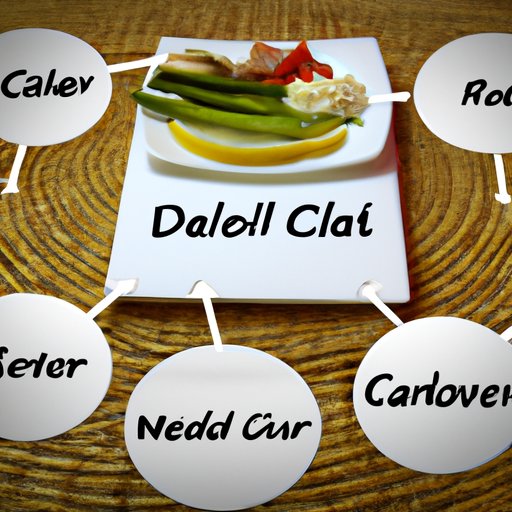Introduction
A low calorie diet is a dietary approach that involves consuming fewer calories than your body needs for energy. It’s a popular weight loss strategy and may also have health benefits, such as reducing your risk of chronic disease. In this article, we’ll explore the basics of a low calorie diet, potential benefits and risks, how to create a meal plan, and tips for sticking to the diet.

Explaining the Basics of a Low Calorie Diet
The number of calories you need depends on your age, sex, activity level, and other factors. Generally, women should consume 1,200–1,500 calories per day, while men should consume 1,500–1,800 calories per day. On a low calorie diet, you’d consume fewer calories than these amounts. How many fewer calories depends on your goals.
When following a low calorie diet, it’s important to focus on nutrient-dense foods. This means eating foods that are high in vitamins, minerals, and other beneficial compounds but low in calories. Examples include fruits, vegetables, lean proteins, and healthy fats.
You’ll want to avoid processed foods, which are usually high in calories but low in nutritional value. Processed foods include things like chips, candy, soda, and fast food.
Benefits and Risks of Following a Low Calorie Diet
A low calorie diet can have several potential health benefits. One study found that people who followed a low calorie diet for 8 weeks lost an average of 9 pounds (4 kg). The participants also experienced reductions in their blood pressure, cholesterol levels, and waist circumference.
Another study found that following a low calorie diet for 6 months was associated with improved metabolic health. The participants experienced reductions in their blood sugar, triglyceride, and cholesterol levels.
However, there are some potential risks associated with following a low calorie diet. If you don’t get enough nutrients, you may experience fatigue, muscle loss, and nutrient deficiencies. You may also struggle to stick to the diet due to hunger or cravings.

How to Create a Low Calorie Meal Plan
Creating a low calorie meal plan can help you reach your goals while still getting all the nutrients you need. Here are the steps you should take:
Calculating Your Daily Calorie Needs
The first step is to calculate your daily calorie needs. To do this, use an online calculator to determine your basal metabolic rate, or BMR. This is the number of calories your body needs to stay alive, even if you don’t move all day. Then, multiply your BMR by an activity factor to get your total daily calorie needs.
Making a Meal Plan
Once you know how many calories you need each day, you can start making a meal plan. Focus on nutrient-dense foods, such as vegetables, fruits, whole grains, lean proteins, and healthy fats. Aim to get a variety of foods from each food group.
To make sure you’re meeting your calorie goals, add up the calories of each food you eat. A good rule of thumb is to aim for meals that are about 300–400 calories each.
What Foods Are Allowed on a Low Calorie Diet
When following a low calorie diet, you’ll want to focus on nutritious foods that are low in calories. Here are some examples:
Healthy Fats
Healthy fats are an essential part of any diet. Good sources include olive oil, avocados, nuts, and seeds. Try to limit your intake of saturated fats, such as those found in butter and red meat.
Proteins
Protein helps keep you full and provides essential amino acids. Good sources include fish, chicken, tofu, Greek yogurt, eggs, and legumes. Aim to get at least 0.8 grams of protein per kilogram of body weight per day.
Carbohydrates
Carbohydrates provide energy and fuel for your body. Good sources include whole grains, oats, quinoa, sweet potatoes, and fruits. Limit your intake of refined carbohydrates, such as white bread and sugary snacks.
Fruits and Vegetables
Fruits and vegetables are packed with vitamins, minerals, and antioxidants. They’re also low in calories, so you can eat a lot without going over your calorie goals. Try to get at least 5 servings of fruits and vegetables per day.
Tips for Sticking to a Low Calorie Diet
Sticking to a low calorie diet can be challenging. Here are some tips to help you stay on track:
Drink Plenty of Water
Drinking plenty of water can help you stay hydrated and prevent hunger. Aim to drink at least 8 glasses of water per day.
Focus on Whole Foods
Whole foods are typically lower in calories than processed foods. Try to fill your plate with whole foods, such as vegetables, fruits, whole grains, and lean proteins.
Get Creative with Recipes
Eating the same foods every day can get boring. Get creative with recipes to keep things interesting. Experiment with different spices, herbs, and seasonings to add flavor to your meals.

Common Mistakes to Avoid When Following a Low Calorie Diet
When following a low calorie diet, it’s important to be mindful of your food choices. Here are some common mistakes to avoid:
Skipping Meals
Skipping meals can lead to overeating later in the day. Plus, it can put your body into starvation mode, which can slow down your metabolism. Instead, try to eat regular meals throughout the day.
Eating Too Much Protein
Eating too much protein can make it difficult to meet your calorie goals. Try to limit your intake to 0.8–1.2 grams of protein per kilogram of body weight per day.
Not Planning Ahead
Planning ahead is key to success when following a low calorie diet. Make a grocery list and meal plan before you go shopping. This will help you stick to your goals and avoid impulse purchases.

Different Types of Low Calorie Diets
There are several different types of low calorie diets, including the keto diet, paleo diet, and intermittent fasting. These diets vary in terms of which foods are allowed and encouraged. Talk to your doctor to find out which type of diet is best for you.
Conclusion
A low calorie diet can help you lose weight and improve your health. To get started, focus on nutrient-dense foods, calculate your daily calorie needs, and make a meal plan. Also, remember to drink plenty of water and get creative with recipes. Just be sure to talk to your doctor before starting any new diet.
(Note: Is this article not meeting your expectations? Do you have knowledge or insights to share? Unlock new opportunities and expand your reach by joining our authors team. Click Registration to join us and share your expertise with our readers.)
